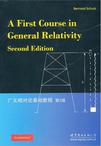广义相对论基础教程
2011-4
世界图书出版公司
Bernard F.Schutz
393
无
《广义相对论基础教程(第2版)(英文影印版)》是一部教程,这是第二版,用尽可能少的数学背景,清晰,易懂,简明地介绍了广义相对论。在相对论的框架内尽可能全面的包括更多的内容,从黑洞到引力透视,脉冲星到整个宇宙学的研究,形成一个有机的整体。书中包括了天体学家的很多重大发现,增加了一章讲述相对论星体,包括了有关脉冲星的最新知识,有关宇宙学的一章完全更新,全面,综合的讲述了现代发展和预期前景。300多道练习题,许多是这本书中新增加的,这让学生有足够的信心学习好广义相对论和必需的数学知识,本书的写作风格更加使得这门科目更加容易理解。目次:狭义相对论;狭义相对论中的向量分析;狭义相对论中的张量分析;狭义相对论中的完全流;曲率介绍;弯曲流形;弯曲时空中的物理学;einstein场方程;引力辐射;星体的球面解;schwarzschild几何和黑洞;宇宙学。
读者对象:适用于高年级本科生及更层次的,对宇宙学,天体物理学,以及引力物理实验感兴趣的科研人员。
作者:(英国)舒茨 (Bernard F.Schutz)
preface to the second edition
preface to the first edition
1 special relativity
1.1 fundamental principles of special relativity (sr) theory
1.2 definition of an inertial observer in sr
1.3 new units
1.4 spacetime diagrams
1.5 construction of the coordinates used by another observer
1.6 invariance of the interval
1.7 invariant hyperbolae
1.8 particularly important results
1.9 the lorentz transformation
1.10 the velocity-composition law
1.11 paradoxes and physical intuition
1.12 further reading
1.13 appendix: the twin 'paradox' dissected
1.14 exercises
2 vector analysis in special relativity
2.1 definition of a vector
2.2 vector algebra
2.3 the four-velocity
2.4 the four-momentum
2.5 scalar product
2.6 applications
2.7 photons
2.8 further reading
2.9 exercises
3 tensor analysis in special relativity
3.1 the metric tensor
3.2 definition of tensors
3.3 the tensors: one-forms
3.4 the tensors
3.5 metric as a mapping of vectors into one-forms
3.6 finally: (m)tensors
3.7 index 'raising' and 'lowering'
3.8 differentiation of tensors
3.9 further reading
3.10 exercises
4 perfect fluids in special relativity
4.1 fluids
4.2 dust: the number-flux vector
4.3 one-forms and surfaces
4.4 dust again: the stress--energy tensor
4.5 general fluids
4.6 perfect fluids
4.7 importance for general relativity
4.8 gauss' law
4.9 further reading
4.10 exercises
5 preface to curvature
5.1 on the relation of gravitation to curvature
5.2 tensor algebra in polar coordinates
5.3 tensor calculus in polar coordinates
5.4 christoffel symbols and the metric
5.5 noncoordinate bases
5.6 looking ahead
5.7 further reading
5.8 exercises
6 curved manifolds
6.1 differentiable manifolds and tensors
6.2 riemannian manifolds
6.3 covariant differentiation
6.4 parallel-transport, geodesics, and curvature
6.5 the curvature tensor
6.6 bianchi identities: ricci and einstein tensors
6.7 curvature in perspective
6.8 further reading
6.9 exercises
7 physics in a curved spacetime
7.1 the transition from differential geometry to gravity
7.2 physics in slightly curved spacetimes
7.3 curved intuition
7.4 conserved quantities
7.5 further reading
7.6 exercises
8 the einstein field equations
8.1 purpose and justification of the field equations
8.2 einstein's equations
8.3 einstein's equations for weak gravitational fields
8.4 newtonian gravitational fields
8.5 further reading
8.6 exercises
9 gravitational radiation
9.1 the propagation of gravitational waves
9.2 the detection of gravitational waves
9.3 the generation of gravitational waves
9.4 the energy carried away by gravitational waves
9.5 astrophysical sources of gravitational waves
9.6 further reading
9.7 exercises
10 spherical solutions for stars
10.1 coordinates for spherically symmetric spacetimes
10.2 static spherically symmetric spacetimes
10.3 static perfect fluid einstein equations
10.4 the exterior geometry
10.5 the interior structure of the star
10.6 exact interior solutions
10.7 realistic stars and gravitational collapse
10.8 further reading
10.9 exercises
11 schwarzschild geometry and black holes
11.1 trajectories in the schwarzschild spacetime
11.2 nature of the surface r = 2m
11.3 general black holes
11.4 real black holes in astronomy
11.5 quantum mechanical emission of radiation by black holes: the
hawking process
11.6 further reading
11.7 exercises
12 cosmology
12.1 what is cosmology?
12.2 cosmological kinematics: observing the expanding
universe
12.3 cosmological dynamics: understanding the expanding
universe
12.4 physical cosmology: the evolution of the universe we
observe
12.5 further reading
12.6 exercises
appendix a summary of linear algebra
references
index
版权页:插图:Although stationary black holes are simple, there are situations where black holes areexpected to be highly dynamical, and these are more difficult to treat analytically. When ablack hole is formed, any initial asymmetry (such as quadrupole moments) must be radi-ated away in gravitational wave.s, until finally only the mass and angular momentum areleft behind. This generally happens quickly: studies oflinear perturbations of black holesshow that black holes have a characteristic spectrum of oscillations, but that they typicallydamp out (ring down) exponentially after only a few cycles (Kokkotas and Schmidt 1999).The Kerr metric takes over very quickly. Even more dynamical are black holes in collision, either with other black holes or withstars. As described in Ch. 9. binary systems involving black holes will eventually merge,and black holes in the centers of galaxies can merge with other massive holes when galax-ies merge. These situations can only be studied numerically, by using computers to solveEinstein's equations and perform a dynamical simulation.Numerical techniques for GR have been developed over a period of sevefal decades, butprogress initially was slow. The coordinate freedom of general relativity, coupled with thecomplexity of the Einstein equations, means that there is no unique way to formulate asystem of equations for the computer. Most formulations have turned out to lead to intrin-sically unstable numerical schemes, and finding a stable scheme took much trial and error.Moreover, when black holes are invoved the full metric has a singularity where its com-ponents diverge: this has someho\x, to be removed from the numerical domain, becausecomputers can work only to a finite precision, See Bona and Palenzuela-Luque (2005) andAlcubierre (2008) for surveys of these problems and their solutions.
《广义相对论基础教程(第2版)(影印版)》由世界图书出版公司出版。

无
是一部广义相对论很好的入门教材
拿着字典看物理书,感觉很好。内容很棒。
翻词典看书
很喜欢,讲得明白
名师出高徒,一本介绍广义相对论的入门书籍,浅显易懂,内容也不少
非常适合入门的一本书~
昨天只看了第一章,对于我这样一点基础的人也没太大障碍,此书讲述的很细,很喜欢,虽然字小了点,但留了不少空白可以记记笔记。不错。
本书的出版无疑是想要在本阶段学习GR的同学的福音,其实第一版自出版以来就很受欢迎,多次重印,第二版作者更新了一些内容(主要是宇宙学方面的),本书的最大特点在于起点很低,将广义相对论所用到的最基本数学知识做了极为精彩的介绍,并且附有大量有意义的习题来巩固所学知识。当然如果进一步学习本书内容显然是不够的。
几乎适合当前所有高中选物理的中学生学习(中国的高中不算在内)